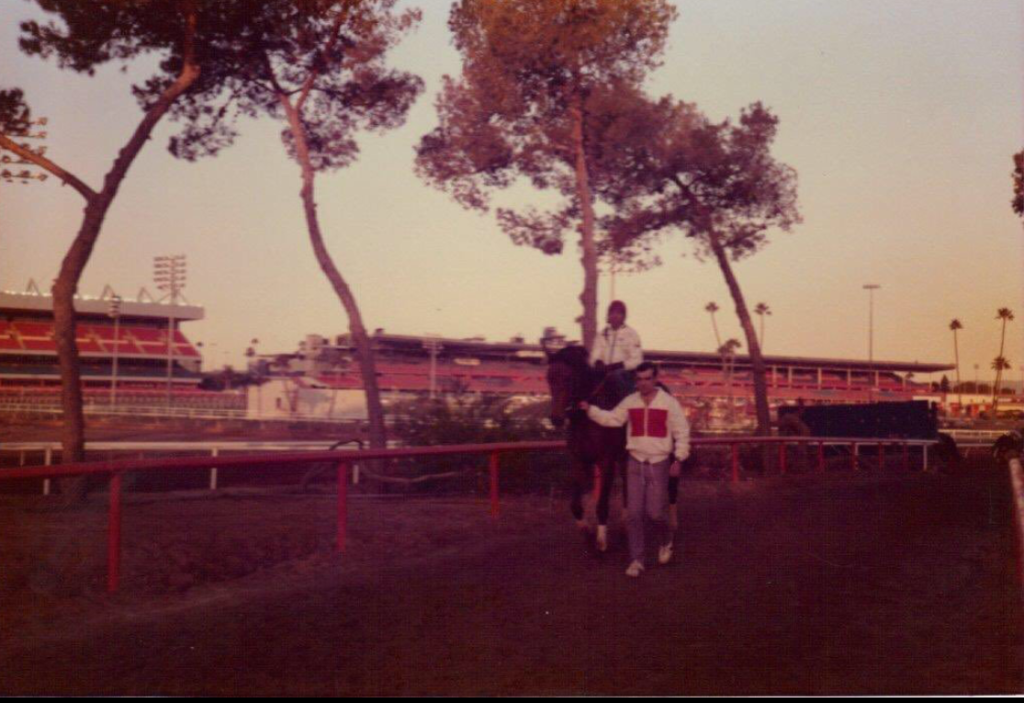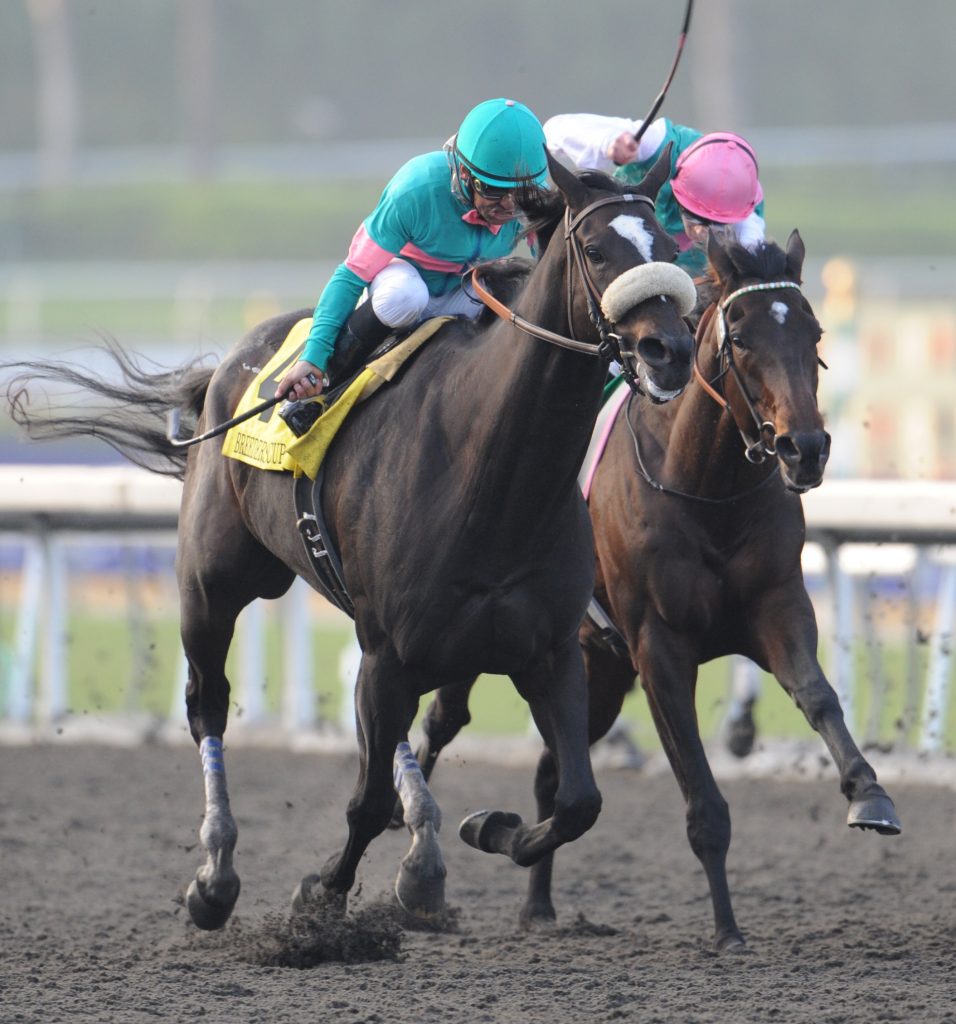
By Margaret Ransom
The Breeders’ Cup was conceived in the early 1980s as a year-end championship for North American Thoroughbred racing and it has only grown in prominence and popularity since. It is the year-end goal for just about every horse’s connections, spots in the starting gate for the now 13 races each year reserved to just 196 of the best of each division.

Longtime owner and breeder John R. Gaines presented the idea to the racing and breeding industry during the 1982 Kentucky Derby Festival and after initially receiving some pushback, the concept was accepted, and the first event was held in 1984 at the now defunct Hollywood Park.
In North America, stallion owners/managers/farms pay an annual nomination fee which is equal to the stallion’s advertised stud fee, plus an additional amount if the stallion has more than 50 foals that year. European stallion nominations is the equivalent to 50 percent of their stud fee, while South American stallions are 25 percent.
Also, breeders must pay a one-time nomination fee per foal by October 15 of the year foaled.
Based on stallion eligibility nominations and foal payments, in 1983 initially 1,083 stallions, representing more than $10.9 million in fees were nominated to the Breeders’ Cup program. Those numbers have grown significantly over the past 39 years.
By the end of 1983, Breeders’ Cup had signed an exclusive broadcasting deal with NBC Sports to cover multiple years of the then seven-race, single-day event. Some of the initial corporate sponsorship for the inaugural event included Mobil Oil Corporation, De Beers Consolidated Mines Ltd., Chrysler Corporation (Chrysler-Plymouth) and Michelob (Anheuser-Busch, Inc.).
This year the Breeders’ Cup boasts such impressive international sponsors like Longines, Maker’s Mark, Big Ass Fans, Fan Duel, The Permanently Disabled Jockeys Fund, The Thoroughbred Aftercare Alliance and Qatar Racing.
The inaugural Breeders’ Cup was held with 64,254 in attendance at Hollywood Park. Chief’s Crown won the first Breeders’ Cup race, the Breeders’ Cup Juvenile, while longshot Wild Again won the Breeders’ Cup Classic in a thrilling stretch duel with Slew o’ Gold and Gate Dancer and after surviving a lengthy inquiry into bumping in the stretch drive. The Classic purse was $3 million in the first 12 runnings, bumped to $4 million by 1996, $5 million in 2005 and has stood at $6 million since 2016.
A year ago at Del Mar, 20,536 people attended the Future Stars Friday program and 26,553 on Saturday Classic Day, which reported the second-highest single-day all-sources handle record of $121,563,235. The record of $140,332,198 in all-sources handle was set at Churchill Downs in 2006. The record for attendance on a single Breeders’ Cup Day is the 80,452 who passed through the turnstiles at Churchill Downs in 1998.
From its inception in 1984 through 2006, it was a single-day event and switched to two days in 2007 and originally, day 1 was devoted to female horses and the overall purses were increased to over $25 million for both days. In 2018 all 2-year-old races were moved to the Friday card and the day was dubbed “Future Stars Friday.” The total purses for the 14 Breeders’ Cup races, as well as eight undercard races, this year will be worth $31 million.
In 2008, the Breeders’ Cup Marathon was added but was dropped by 2014. Also, in 2011 the Juvenile Sprint was added, only to be dropped after the 2012 running. And in 2008 at Santa Anita the main track races were contested over a synthetic surface instead of traditional dirt.
The races added in 2007 were Breeders’ Cup Dirt Mile for 3-year-olds and up, the Breeders’ Cup Filly & Mare Sprint for fillies and mares, 3-year-olds and up; and the Breeders’ Cup Juvenile Turf, a one-mile event for 2-year-olds. That year the Dirt Mile was contested at a mile and 70 yards as the Monmouth Park main track doesn’t typically offer one-mile dirt races due to the track’s configuration, and the Filly & Mare Sprint, now at seven furlongs, was set at six furlongs for the same reason.
The Juvenile Fillies Turf and Juvenile Turf Sprint were added to the lineup later and continue today.
In 2009, the Breeders’ Cup announced that it would switch from the traditional purple saddle towels and instead use the standard colored saddle towels. Before then, the only time purple saddle towels weren’t used were in the inaugural event when all runners wore gold towels.
Breeders’ Cup also introduced the Breeders’ Cup Challenge “Win and You’re In” qualifying system in 2007, a policy wherein winners of major races throughout the year from around the world and North America would gain an automatic spot in the Breeders’ Cup Championships starting gate. This year a total of 83 Breeders’ Cup Challenge races were offered throughout the year.
Irishman Joseph O’Brien, the son of champion trainer Aidan O’Brien, holds the distinction of being both the youngest jockey and trainer to have ever won a Breeders’ Cup race. In 2011 he rode St. Nicholas Abbey to victory in the Breeders’ Cup Turf and in 2019 he saddled Breeders’ Cup Filly & Mare Turf winner Iridessa to victory.
Other interesting but off-the-beaten path statistics for the Breeders’ Cup world championships:
Oldest Horses to Run in a Breeders’ Cup Race
Cloudy’s Knight, 9 Years Old (2009 Marathon)
John’s Call, 9 Years Old (2000 Turf)
Bet On Sunshine, 9 Years Old (2001 Sprint)
Calidoscopio (Arg), 9 Years Old (2012 Marathon)
Oldest Horse to Win a Breeders’ Cup Race
Calidoscopio (Arg), 9 Years Old (2012 Marathon)
Oldest Trainer to Win a Breeders’ Cup Race
D. Wayne Lukas (79), Take Charge Brandi (2014 Juvenile Fillies)
Youngest Trainer to Win a Breeders’ Cup Race
Joseph O’Brien (26), Iridessa (2019 Filly & Mare Turf)
Oldest Jockey to Win a Breeders’ Cup Race
Bill Shoemaker (56), Ferdinand (1987 Classic)
Youngest Jockey to Win a Breeders’ Cup Race
Joseph O’Brien (18), St Nicholas Abbey (IRE) (2011 Turf)
First Winning Female Trainer
Jenine Sahadi, Lit de Justice (1996 Sprint)
First Winning Female Jockey
Julie Krone, Halfbridled (2003 Juvenile Fillies)
More Breeders’ Cup Odds and Ends
Breeders’ Cup Favorites and Longshots
-Favorites have won 116 of 374 Breeders’ Cup races, a 31 percent rate.
-The worst finish by a favorite was in the 2003 Juvenile at Santa Anita Park when Cuvee finished 12th by 58 lengths at odds of 3-2.
-There have been 65 odds-on (¢.90 or less) choices with 28 winners.
-There have been 45 horses to go off at odds of 100-1 or greater but only Arcangues, winner of the 1993 Classic at 133.60-1, has finished in the money.
Lowest/Highest Odds for Each Breeders’ Cup Race Winner
Classic:
2015: American Pharoah — ¢.70
1993: Arcangues — $133.60
Dirt Mile:
2015: Liam’s Map –– ¢.50
2010: Dakota Phone –– $37.70
Filly and Mare Turf:
2004: Ouija Board — ¢.90
2010: Shared Account — $46.00
Filly & Mare Sprint:
2012: Groupie Doll –– ¢.70
2017: Bar of Gold –– $66.70
Juvenile:
1984: Chief’s Crown — ¢.70
2019: Storm the Court –– $45.90
Juvenile Turf:
2009: Pounced –– $2.40
2020: Fire At Will –– $30.20
Juvenile Fillies:
1990: Meadow Star — ¢.20
2014: Take Charge Brandi — $61.70
Juvenile Fillies Turf:
2018: Newspaperofrecord — ¢.60
2019: Sharing –– $13.80
Juvenile Sprint:
2011: Secret Circle — $.40
2012: Hightail — $15.40
Juvenile Turf Sprint:
2020: Golden Pal — $.80
2021: Twilight Gleaming –– $5.20
Distaff:
1985; Life’s Magic — ¢.40 (coupled with Lady’s Secret and Alabama Nana)
2000: Spain — $55.90
Marathon:
2009: Man of Iron — $6.40
2011: Afleet Again — $41.60
Mile:
2013: Wise Dan — ¢.80
2020: Order of Australia — $73.20
Sprint:
1984: Eillo — $1.30
1991: Sheikh Albadou — $26.30
Turf:
Enable: — ¢.80
Laskari: — $53.40
Turf Sprint:
Regally Ready: —$2.30
Desert: — $36.50
The most successful post position in Breeders’ Cup history has been post 5, which has produced 42 winners in 38 years. The least successful post has been post position 13, but the races didn’t allow more than 12 starters until recently.
Winning Post Positions
Post Position 1 36 Winners
Post Position 2 36 Winners
Post Position 3 28 Winners
Post Position 4 41 Winners
Post Position 5 42 Winners
Post Position 6 31 Winners
Post Position 7 25 Winners
Post Position 8 25 Winners
Post Position 9 29 Winners
Post Position 10 19 Winners
Post Position 11 27 Winners
Post Position 12 19 Winners
Post Position 13 5 Winners
Post Position 14 11 Winners



